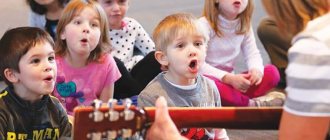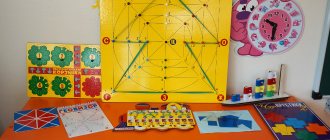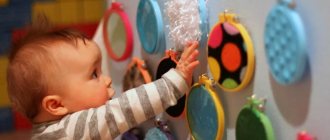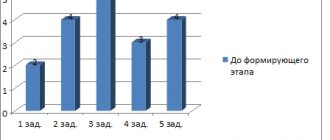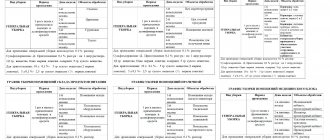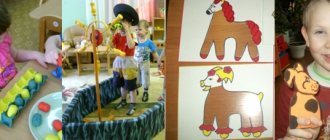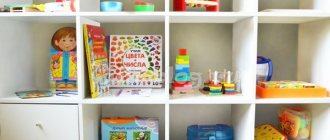Parents who seriously think about the future of their child try to start their education from an early age, using the experience of past teachers who have proven the validity of their views in practice. Nikitin’s methodology, which is aimed at the development and education of children in a playful way, does not lose its relevance.
Goal and tasks
As the Nikitins believed, the key goal of raising a child is the development of a creative personality, and it is on this that the basic principles of the methodology are based. The purpose of the system they developed can be formulated in a similar way.
The objectives of the methodology are:
- harmonious intellectual and physical development of the child from an early age;
- the formation of his independence due to the non-interference of parents in the process of solving a specific problem;
- doing certain exercises helps the child understand colors and basic geometric shapes;
- didactic games are aimed at developing the child’s logic, thinking, and memory in an unobtrusive and easy way.
Many developmental tasks of the Nikitin family appeared during their direct communication with children, with the participation of the latter, and therefore are accessible to children, useful and interesting to them.
Feedback from teachers about the Nikitins’ methodology
The system of experimenters was highly appreciated by famous contemporary teachers:
“The Nikitins’ experience interested me very much, since I pay special attention to issues of improving modern pedagogy and educational processes. Their experimental approach is extremely important for the public education system, and therefore should be studied with special care,” said mathematician and member of the Academy of Sciences Alexei Andreevich Lyapunov.
“The Nikitins showed extreme observation and intuition. Their system is of particular value for disadvantaged children,” said physiologist and academician Ilya Arkadyevich Arshavsky.
“I know the Nikitins’ children and students. These are brilliant problem solvers who know how to find a way out of different life situations, have ingenuity, good speech, and are several grades ahead of the school curriculum,” said Honored Doctor Nikolai Mikhailovich Amosov.
History of creation
The system appeared in the second half of the 60s of the twentieth century and immediately attracted everyone’s attention, since the Nikitins’ approach differed significantly from the norms and principles that reigned in Soviet didactics. The first publication by teachers was published in 1962, and later the proposed innovations attracted the interest of specialists abroad - in Germany and Japan.
The Nikitin methods were developed by those people for whom the problem of raising children was relevant, because the spouses Lena Alekseevna and Boris Pavlovich had seven of them. They not only offered other parents to get acquainted with their own experience, but also, being professional teachers, actively used their knowledge. The Nikitin children began studying mathematics and writing at the age of 3-4 years. The couple tried to raise their children in conditions as close to natural as possible, paid great attention to hardening, physical activity, and provided the children with complete freedom of movement from birth.
The history of the appearance of Nikitin’s technique
From a young age, Boris Pavlovich dreamed of creating a radically new school, in which teaching children would be significantly different from the pedagogy of that time. Following his heart, he changed his professional activity in the field of aviation to teaching. Fate gave him a woman who became his wife and comrade-in-arms in realizing his cherished dream. Seven children were born into the family of teachers, who became the “pioneers” of a new approach to physical, emotional and intellectual education.
B.P. Nikitin not only came up with new methods for developing memory, creativity, and logical thinking, but also practiced physical education with hardening with water, fresh air, and avoidance of medications. His technique caused confusion and criticism. However, the results of his upbringing were excellent. All the children were healthy, many could read and count from an early age. They easily passed high school programs as external students, graduating from school much earlier than their peers. Almost everyone received higher education at universities, graduating with honors.
In the 60-90s, the couple described their principles of raising children in books. They supplemented the theory with practical tasks, educational games, and toys. The technique became widely known throughout the world, and the works were translated into other languages.
Advantages and disadvantages
The advantages of the technique include the following.
- This approach allows you to achieve comprehensive physical and intellectual development.
- Helps improve logic, intelligence, spatial thinking, imagination, memory, and the ability to find non-standard paths.
- Teaches kids to be independent, persistent and purposeful from an early age.
- Helps to gain basic knowledge about the most important abstract concepts, which will be useful in the future at school.
It should be noted that the technique is not without its drawbacks.
- Exercises and games are carried out with the interaction of the baby and parents, which, of course, is very useful, but limits the child’s communication with peers.
- The development of a preschooler will not be comprehensive when using only the Nikitins’ methodology, so it should be supplemented with recommendations from other teachers.
- The system is focused on home education, so often children who developed exclusively using this method find themselves unprepared for school life.
- Due to the lack of story-based and role-playing games, the baby does not learn to play; throughout the day he trains his brain, which leads to significant energy expenditure and causes fatigue. Such a child is deprived of many bright moments of childhood.
Let us note that the method has far fewer disadvantages than positive aspects, and they can be easily removed by caring parents who will give their child the opportunity to communicate with peers, play with them the way the child himself wants, and relax.
Features of the Nikitins’ developmental methodology
The main feature of the methodology of Russian teachers is that it is based on practical experience. This is not a dry theory, but knowledge supported by proven facts. It involves creating an environment that stimulates the child to develop and learn new things.
The purpose and objectives of the methodology
The main goal is to prepare the child for life through the maximum development of his creative and intellectual abilities and physical development.
Teachers paid special attention to children's health. From an early age, children should play sports, eat healthy and simple food in moderation, wear comfortable clothes and harden themselves. To improve their health, the Nikitin children walked barefoot in the snow and doused themselves with cold water. The temperature in the rooms was always 18 degrees. This yielded results - all the guys practically did not get sick and were in excellent health.
As parents, the Nikitins stimulated children's interest in various sports, explained the importance of physical and intellectual development, and allowed them to choose activities in accordance with their interests. Their task is to let the child understand that his parents support him, share his views and are always ready to help. This made it possible to raise holistic and comprehensively developed individuals, despite the negative consequences of the popularity of the family.
Basic principles and rules of the Nikitin methodology
Russian teachers adhered to the following principles of child development:
- The educational process must be balanced. Such an extreme as “over-organization” is unacceptable, i.e. excessive care, focusing adults' attention solely on the child. The opposite extreme – “abandonment” or ignoring – is also harmful.
- No coercion. The child does what he likes and wants. The teacher’s task is to create favorable conditions that stimulate natural curiosity and the desire to do useful things.
- Naturalness. The Nikitins allowed children to wear loose clothes, spend a lot of time in the fresh air, and observe nature. The house had simple but comfortable furnishings.
- Parental involvement. Adult participation is very important. They should share interests, spend time together: play, watch nature, help with homework, etc.
It is possible to develop children according to the Nikitins’ method only with the cooperation of teachers and parents. If this system is practiced in a kindergarten, parents should also be involved in the process, spend time together on weekends, etc.
Advantages and disadvantages
The system developed by Russian teachers is widely used due to the following advantages:
- An integrated approach to development.
- The child develops strong immunity to various diseases.
- Curiosity is encouraged as the main driver of learning. The child strives to learn new things and learn.
- The child receives practical knowledge and skills. He is not afraid to make mistakes and knows how to quickly find solutions in different situations.
- High intellectual development.
However, the technique also has opponents who insist on its shortcomings:
- Since the child is accustomed to doing only what interests him, he may study some school subjects superficially, because they do not arouse interest.
- Close communication between parents and child limits the circle of communication with peers. In large families the problem is not so pronounced. In addition, parents must devote all their time to parenting, which is not always possible.
Even the Nikitin children themselves, despite the full support of their parents, still refused to send their own children to school ahead of schedule. The lack of communication with peers in their own childhood affected them.
Main principles
The spouses explained their position as follows: their task is to educate not geniuses, but self-sufficient and harmonious individuals, who are characterized by a cognitive beginning, keen interest, the desire to create, and the presence of their own position.
The Nikitins’ technique is based on the “three pillars” - fundamental principles.
- Children need special conditions that promote mental and physical development, so parents should carefully consider the design of the children's room: it should be cozy and comfortable. To help your child learn naturally, you can hang cards with letters, an image of a world map, and number tables on the walls.
- The parent’s task is to offer the child a task, but not to impose an approach to solving it, much less the correct answer. The main thing is that the child must show creativity, only in this case the result will be positive. The Nikitin exercises are structured in such a way that several possible solutions are possible.
- Close interaction between the child and his parents is key in the educational process.
Based on these principles and using the developmental benefits of the Nikitins, parents will be able to help their children grow up as harmonious and gifted individuals who do not experience problems in communication and socialization.
Games with miracle cubes for children aged 2-5 years
For older children, a good helper in the game will be the album of tasks “Fold a pattern for children from 2 to 5 years old . With the help of tasks from the album, you can teach children to compare objects by size (large - small, tall - short, long - short, wide - narrow), transform images and recreate a whole image of a figure from parts. Also, during the game, the children will be able to practice their counting skills.
- Anya, whose path is longer? Whose is shorter? How many cubes will be needed to build the first track? And the second? Please help Little Wolf build a path the same length as Goose’s.
Very useful and interesting are the tasks in which the child needs to unfold the cubes to build a specific pattern.
At first, Anya coped very poorly with such tasks. She turned the cube for a long time and could not understand how to place it in order to get the desired pattern. But later (after about 2 weeks of daily tasks), to my joy, everything began to work out for her.
- Anechka, let’s build a fence for the cats. Oh, just be careful, the fence is not simple, but with a pattern. To build it, you need to use not simple, but magic cubes to build a pattern.
You can also complicate the tasks and show drawings for construction on a scale of 1:1 with a solid image (the boundaries between the cubes are not drawn). This type of activity belongs to the second level of difficulty.
- Anya, look what a snake crawled to visit us today. Let's break her spell. To do this, it must be built from cubes. Let's make a friend for our snake so that she won't be bored.
Major works
The spouses Lena and Boris Nikitin have written a large amount of educational literature that can be used by modern parents.
Let's list the most famous benefits:
- “The first lessons of natural education, or Childhood without illnesses.”
- "Our lessons."
- "Are we right?"
- "Mind games".
According to their methodology, the child had to begin his education from an early age, and we are talking not only about physical, but also about mental development. That is why all kinds of sports equipment were placed for children, books and visual aids were freely available. At the same time, no one should limit the child’s choice; only he himself could determine what exactly he would do. In modern life, it is quite difficult to fully adhere to this technique, because it is focused on the constant presence of both the child and his mother at home, but parents can safely use elements of intellectual and educational games that will help prepare the child for school, improve his thinking, imagination, and memory.
Master class “Use of B. P. Nikitin’s educational game “Fold the Pattern” in working with preschoolers”
Inga Dorofeeva
Master class “Use of B. P. Nikitin’s educational game “Fold the Pattern” in working with preschoolers”
Goal: to introduce master class participants to the practice of using the educational game B. P. Nikitina “ Fold the pattern ”
in
working with preschool children .
Material: games B. P. Nikitina “ Fold the pattern ”
.
Best age for classes
Nikitin's complex of educational games can be used for preschoolers of all ages, since by changing the tasks it is easy to increase the level of complexity of the game itself. You can start training with cubes from the age of 1.5 years, this will contribute to the development of fine motor skills. For the little ones, it is enough to use cubes of the same color, simply lay them out, trying to create a “path”. At 3–4 years old, you can safely offer children multi-colored cubes and complicate the task, asking them to put together a pattern.
What are Nikitin cubes
The famous teacher Boris Nikitin, when creating his unique intellectual tasks for children, adhered to the principle that the child must figure out the rules of the game himself. Among its main tasks are the development of independence, the desire to create new things, and the training of logical and abstract thinking. Wooden or plastic Nikitin cubes are sold 16 pieces per set.
Each figure has 6 sides, which are painted in different colors. Typically these are red, green, blue and yellow. The child needs to collect one-, two-, three- or four-color pictures, based on tasks from a special album. Nikitin’s method involves different versions of problems, for example, “Fold the pattern”, “Cubes for everyone”, “Bricks”, “Fold the square” and “Unicube”.
How to play
The essence of the games is to put pictures from cubes into a pattern or shape. The tasks differ from each other in difficulty level. The simplest task is to fold the shapes into a 4:4 square. Later, when the child gets the hang of it, you can create patterns with many edges. For example, you can build a tower or a snake, a Christmas tree, a house, a flower, a tree. The finished outlines of the drawings will be similar to some object or simply resemble an interesting pattern.
In his book “Steps of Creativity, or Educational Games,” Nikitin recommends organizing the game so that the activities bring pleasure to the child himself - the puzzle should interest the child, so that in the future he himself will be drawn to collect new figures. You can simultaneously tell the little ones a fairy tale or a fascinating story related to the figure being assembled. Nikitin blocks are suitable for collecting any multi-colored patterns.
However, you should not disturb children with hints: it is better if the child comes up with a figure himself, even if it differs from the given sample. It is also better to look for errors yourself.
In addition, Boris Nikitin gives parents some advice:
Basic benefits
The Nikitin spouses’ method involved the comprehensive development of physical strength and endurance, intelligence and creative potential, and therefore included a large number of benefits.
- The wall bars, jump rope, turnstiles, and balls helped the child train his body.
- Cubes, development boards, and puzzles helped improve logical thinking and creativity.
The constructor is also actively used. Working with the benefits is simple - the child is given a specific task that he must complete.
Games with miracle cubes for children from 2-3 years old
The activity book “Fold a pattern for kids” . The album contains tasks of the first level of difficulty. The cubes in the diagrams are drawn on a scale of 1:1, the boundaries of the cubes are clearly drawn.
- Anya, please help the bunny build a path to the carrot.
- What do you think, what color cube should be placed in the picture to make a whole apple and pear?
Mind games
The development of a child’s creativity presupposes the development of his intellect, therefore, in the Nikitin spouses’ method, all kinds of games that are interesting to the child and at the same time useful to him are of great importance. The Nikitins’ method is convenient in that it not only contains theoretical justifications for the rules of working with children, but also offers a set of specific play aids that parents can include in their child’s daily routine. There are many options.
Montessori frames and inserts
This set is intended for children from one year old. It consists of 16 frames and geometric shapes corresponding to them; the child is required to understand which particular shape fits a particular frame and place it “in place.” For the youngest, the task is significantly simplified - they are given the frame itself and a figure (for example, a circle) - the child must understand how to combine them. For children 4-5 years old, you can diversify the exercise - outline both the frames and the inserts, and paint over them.
Unicube
Aimed at developing the child's thinking and attentiveness, it is a set of 27 cubes, the edges of which are painted in different colors. The adult’s task is to give the child a specific task (you can come up with it yourself, for example, build a house out of cubes, stack several cubes so that only the red edges become visible, or look at it in an illustrated instruction book). The educational game will be interesting and useful for children from 1.5 years old. Until the age of three, you can offer the simplest actions, for example, simply placing cubes in a box.
The Nikitins' spouses categorically do not recommend interfering in the process of solving a problem; all that is required from parents is praise for success, and the child must cope with the goal on his own. If adults think that a child is acting “wrongly,” they should still be given creative freedom. There are no wrong decisions, but non-standard ones are quite possible.
Types of Nikitin cubes
Practical teacher Boris Nikitin developed his own method of educational games 40 years ago. The first children to grow up with his toys were the teacher’s own grandchildren. Now educational games are known not only in Russia, but throughout the world.
Before you decide to buy, decide what qualities you would like to develop in your child: logic, eye, imagination, logical and spatial thinking, etc. Based on this, choose a set. Nikitin’s method for children leaves room for choice to suit every taste: decide what colors the edges will be painted in, how many parts the manual consists of.
Fold the pattern
The simplest option is a set of 16 plastic or wooden cubes and an album with tasks, packed in a box. This technique is also called Nikitin's puzzles. It is suitable for beginners.
Fold a square
For children who have already mastered the simplest tasks, game options with unevenly colored figures are suitable:
Unicube
A useful skill will be the ability to assemble three-dimensional shapes - from geometric ones to funny houses or animals. There are special kits for this:
Cubes for everyone
When the child gets comfortable with the blocks, you can offer him one of the most difficult games in the series. At an advanced level, children can assemble objects from two or three figures - animals, a house, cars. The expected age of the child is 5-7 years.
Bricks
Those parents for whom the environmental characteristics and safety of toys are of great importance will like the variation with wooden blocks. They are more durable, although your baby may prefer less of the bright, lightweight plastic cubes.
"Fold the pattern"
This game set is deservedly popular. It consists of 16 cubes of the same size, the edges of which are painted in four different colors. There are single-color edges, two-color edges in two variations (fragments of different colors are placed diagonally or in a straight line), 3- and 4-color. The child’s task is to put them together into a pattern; at the initial stage, you can use ready-made options from the instruction book, and then use your imagination and come up with all sorts of combinations yourself. The best age to perform exercises with patterns is from 4 to 8 years.
If necessary, you can create a developmental manual yourself using ordinary wooden cubes and colored paper.
Boris Pavlovich Nikitin proposed to follow the path “from simple to complex” and use the following types and forms of work:
- Children aged 1.5-2 years are best at imitating, so an adult can show an example - build a “path”, turret, train or other simple figure from cubes.
- At 2-4 years old, you can safely start working with flowers, inviting your child to repeat a harmonious pattern previously invented by the parent; it can be either a “path” or a “square”. With each lesson, the patterns themselves should become more complex.
The number of “patterns” folded in one game depends on the child’s abilities and desires. For one, 4-5 different variations will be enough, another child will not calm down until he has collected more than 10. The goal of the parents is not to impose their will, but also not to limit the desire.
- A more complicated version of the game is to fold a pattern based on a finished illustration, but change the colors (for example, on a card the picture is blue and white, but the child needs to fold a red and yellow one).
- As soon as the child begins to assemble such complex variations as “saw”, “flashlight”, “slides” without any problems, you should invite him to copy the resulting pattern from the cubes onto a piece of checkered paper.
- Finally, the most difficult form of work is to come up with a pattern by arranging the cubes in the required order, redraw it and paint over it.
The game “Fold the Pattern” is interesting for children, it helps to develop their intelligence, the ability to analyze and synthesize, the ability to think logically, and combine colors and shapes.
"Fold a square"
The didactic material has three levels of difficulty and is a set of 12 squares, each of which is painted in its own color and intricately cut into pieces. The child’s task is simple - to assemble a whole square; he will be required to select “pieces” of the required color and put them together into the correct shape. You can start working with the simplest version of the “Fold a Square” puzzle from the age of two.
You should act according to the principle “from simple to complex”: first invite the child to assemble a square of three parts, then move on to a more complex option - a square divided into 5 or 6 fragments. Finally, the smartest ones can be offered to create a whole from 7 parts.
Examples of games using the Nikitins' method
Game "Fold the pattern"
This game comes with 16 cubes of the same size. The standard is 3 x 3 x 3 cm. In this case, the faces of each cube are painted in 4 colors, and two of the 6 faces (opposite) are painted in different colors diagonally. Thus, only 4 colors are involved.
You can make different patterns from the cubes, choosing colors in any order.
By rearranging the cubes, you can create a large number of options for paintings, patterns, schemes, coming up with names for them.
In this game there are three standard tasks: to create a similar pattern according to a given (drawn) pattern, then to create (sketch) a pattern using the pattern folded with cubes, and the third is to come up with new patterns from 9 or 16 cubes.
Schemes - tasks on ready-made cards for the game can be selected in full size so that they can be covered with cubes.
With toddlers, you can play “Fold the Pattern” by first using 4 cubes, making one-color pictures, then gradually introducing the next cubes, making the pattern more complex. You can offer to create a simple pattern yourself and come up with a name for it.
Pupils of senior preschool age can have exciting competitions in the game “Fold the Pattern”. If you divide them into several teams and distribute a set of cubes, then the children will be happy to wait for a new task from the leader and put together patterns according to the diagram. And the teacher can summarize the results in a table, which team added faster, which was more correct, and which came up with more new patterns.
B.P. Nikitin invites adults to pay attention to one very important point: just as we take out a box of cubes, carefully lay them out or noisily dump them all at once, so children will either carefully collect the cubes after playing or scatter them around the room. Handling objects is stored in children's memory; children tend to imitate adults in everything.
By playing “Fold the Pattern,” kids learn to think independently, control and evaluate themselves, and see their own mistakes.
Game "Frames and inserts Montessori"
The basis of this game is mainly the pedagogical developments of the Italian teacher M. Montessori. B.P. Nikitin only slightly changed the completeness and conditions. Game tasks introduce preschoolers to geometric shapes, prepare children's hands for writing, and develop logical thinking.
The game set consists of square plates - frames measuring 10 x 10 cm and about 2 mm thick. Each frame has a hole in the center into which an insert of the corresponding geometric shape and suitable size is inserted, but differing in color.
Here is a list of figures:
- Circle
- Square
- Equilateral triangle
- Ellipse
- Rectangle
- Rhombus
- Trapezoid
- A quadrilateral with irregular sides and one right angle
- Parallelogram
- Isosceles triangle
- Hexagon
- Five pointed star
- Right isosceles triangle
- Pentagon
- Irregular hexagon
- Scalene triangle.
During the game, the frame with the corresponding insert must be named according to the shape of the figure (rhombus, star, circle, etc.).
The number of frames and game tasks for each game are prepared in accordance with the age and capabilities of the children.
Task options:
- Find inserts and insert into frames
- Trace the outlines of the figures (along the frame, along the insert)
- Color the figures with colored pencils
- Outline the figures with a double outline
- Create an ornament from figurines
- Guess the figure by touch
- Insert the inserts into the frames with the eyes closed
- Arrange frames and figures - inserts according to properties.
Game "Monkeys"
This wonderful game is based on children's ability to imitate. Children often copy the behavior of adults, thereby adopting habits, ways of handling objects, and emotions. Young preschoolers have very developed qualities such as attention, observation of adults, and the ability to imitate. These qualities change with age. The game "Monkeys" allows you to evaluate how attentive a child is, or whether this quality is fading.
The game is designed for children from 2 to 3 years old. Children need to be seated at a table so that they can hide their hands under it. The presenter begins the game with a short introduction - a fairy tale: a little monkey was sitting in the room, she was bored, she saw a boy, first hid from him, and then began to repeat all the movements after him and she really liked it. Now all the children - the monkeys - repeat the movements after the boy - the leader (teacher). For the kids, you need to prepare identical wooden blocks or bricks and distribute 2 pieces to each. You can borrow them from any gaming kit. The presenter raises his hands from behind the table and puts his bricks in a certain composition, places them on the edges, in a tower, in the letter “T”, in any way. Children - monkeys must repeat the composition exactly - exactly - from their blocks. In this case, the leader must perform the movements demonstratively slowly, sometimes a little faster, noisily or quietly, but very emotionally, verbally encouraging the monkeys. Having finished the composition, they begin the next one. Having hidden their hands under the table, then taking out the figures, the monkeys again repeat after the leader and build a new composition.
As a result, children develop attention and learn to repeat the actions of the leader. You can complicate the game by introducing new figures, including different colors.
The list of Nikitin games and puzzles is quite large. All of them are aimed at developing logical thinking, memory, attention, and creative imagination. Children's talents need to be developed from an early age, creating a creative environment and engaging the child with intellectual games. Lena and Boris Nikitin think so. And all teachers agree with them on this.
If you found the information on the site useful, please share it on social networks:

